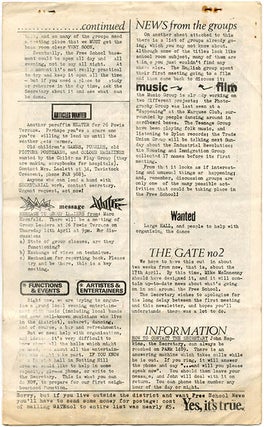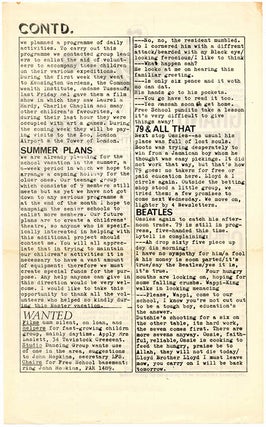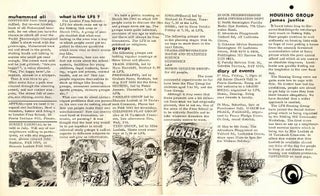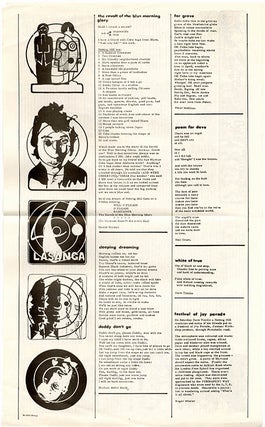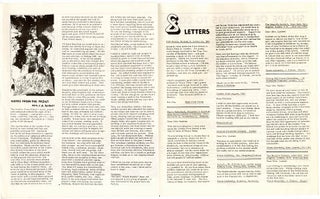36.
THE GATE Vol. 1, #1 (April 4, 1966), issued as a staple-bound insert in The Long Hair Times (c. April 8, 1966); THE GATE Vol. 1, #2 (April 21, 1966); THE GROVE Vol. 1, #3 (May 9, 1966); THE GROVE Vol. 1, #4 (May 23, 1966); THE GROVE Vol. 1, #6 (September 17, 1966).
Formats and sizes vary (first four issues single sheets, printed rectos and versos, the fourth one folded to make 4pp.; issue #6 two sheets, each folded to make 8pp.). Edited and printed offset litho by John ‘Hoppy’ Hopkins, and designed by Mike McInnerney, including his ampersand logo from the second issue on.
A good run of the London Free School’s newsletter, featuring a rare (though incomplete) copy of The Long Hair Times. Starting with the third issue, the title changed from The Gate to The Grove, an alteration initiated by Hoppy who, according to Courtney Tulloch, “wanted to show how in touch with black people he was” (in the preceding issue, Michael de Freitas drew the distinction between the local Black community, who lived in the Ladbroke Grove neighbourhood, and the largely white, often transient hippies who referred to it as Notting Hill Gate: “The Grove as we black ones call it, The Gate as it is commonly called by Free School people”).
i) some copies of the first newsletter were handed out locally. In the second issue, Michael de Freitas mentions Tod Lloyd standing on the corner of Westbourne Park Road “giving out the first Newsletter of the LFS”; later, in his autobiography, Michael describes how, on seeing the difficulty Lloyd was experiencing in giving copies away, more success was found in actually charging for them. Most people, however, encountered it via The Global Moon Edition Long Hair Times, the one-off forerunner of International Times. 500 copies of Miles and Hoppy’s magazine were printed, of which about 300 were sold by Kate Heliczer, Julie Felix, Harry Fainlight, Sue Miles and the editors on the Easter 1966 CND march from Aldermaston to London (the copy here bears the original owner’s name, his inscription “Easter March 1966” and the CND symbol).
As well as featuring the first issue of The Gate, which provides detailed reports on the LFS’s first public meeting, and on the subsequent meeting held at Housmans a few days later (see item #35), the magazine’s other contents include a competition sponsored by Paul McCartney to find a script for a movie (using his backwards-tape pseudonym, ‘Ian Iachimoe’); a statement from the Timothy Leary Defense Fund; John Wilcock’s letter to Miles from New York on Andy Warhol/Velvet Underground and the US scene; an LSD cartoon strip called ‘Sugarman’; a letter to Miles from a La Jolla Pump House Gang surfer; and Ron Atkins’ “Jazz Happenings”. Lacks the final sheet (Ed Sanders’ newsletter, Harry Fainlight’s declaration about the pleasures of LSD, and Hoppy’s drug column); staples slightly rusty, with front cover detached from upper staple; some age-toning and light creasing; o/w Very Good.
ii) as well as printing Michael de Freitas’s piece, titled “On The Black Beat”, the second issue includes news of the second full meeting of the LFS in All Saints Church Hall on April 24, and community activist and former social worker Rhaune Laslett writing about her Children’s Workshop and plans for summer activities. Minor corner wear, o/w Near Fine.
iii) the third issue prints LFS news and a diary of events; a report from Mike Laslett (son of Rhaune) on the Teen Group (see item #37); and a cartoon by Vernon Kirby, “a full-time freelance cartoonist living in the neighbourhood.” Fine.
iv) Muhammad Ali’s visit to the children’s group (“in the sitting room of Mrs Laslett”) on May 15 features on the front page of the fourth issue, illustrated with a photograph “by LFS Photographic Group”, ie. Hoppy and Graham Keen (the photo is by Hoppy). Michael de Freitas contributes a piece on his “recent acquaintance”, Rhaune Laslett, and concludes by mentioning Ali’s visit: “… a treat… I asked him to come” (several years later, after Michael had relocated to Trinidad, Ali visited him at his agricultural commune in Christina Gardens; and it was there that he dreamt up another scheme, inspired in part by Alexander Trocchi’s vision of a ‘Spontaneous University’, that drew on his experience with the London Free School. Called ‘The First University of the Alternative’, it was to be an educational centre up in the hills not far from Christina Gardens, but like so many of his grand plans, nothing ever came of it.) This issue also prints news of a “Street Carnival to be held in July”, dates for upcoming group meetings, a diary of events, and a report on the LFS’s Housing Group, with mention of its instigator, Pete Jenner (then still an assistant lecturer in the Department of Social Admin at the LSE, soon to become Pink Floyd’s first manager, and later the Notting Hill Carnival’s first treasurer). Fine.
v) the sixth issue celebrates a circulation of 2000 in a front cover starburst, overprinted on a facetious account of the LFS’s request to Kensington Borough Council for financial support for a playground and Notting Hill Fair. It quotes former Labour councillor Olive Wilson as saying that they would “get the money if we got rid of Michael X, communists, anarchists etc.” Other contents include “The Big Lie: LSD-25” by Tom McGrath, a hallucinogenic scenario for an imaginary TV programme featuring Babra [sic] Streisand, Jonathan Aitken, Timothy Leary, John Wilcocks, Michael Horovitz and Lenny Bruce; poet Neil Oram on the LFS Fantasy Workshop; a centrespread printing poems by Dan Richter, Michael Abdul Malik, Peter Hoffman, Neil Oram, Dave Tomlin, and Roger Whelan (soon to be in charge of distribution for International Times), accompanied by Mike McInnerney’s artwork; “Notes From The Front” by Rhaune Laslett; and a selection of letters, including from Simon Vinkenoog and Muhammad Ali.
The back page lists details of the “Shape of Things to Come”, ie. the Notting Hill Fayre, mentioned on page 2 as “A week long entertainment organised by Mrs. Laslett”. The programme lists a culturally eclectic and multi-racial cornucopia of ideas and events, including a pageant starting from Acklam Road, evenings of folk singing, jazz and poetry, a carnival dance and Mardi Gras, a festival of avant-garde films (by Harvey Matusow, John Latham, Al Hansen, Yoko Ono, Anthony Cox, and Anne Lockwood, among others), and, on September 23, a “A Mystery Night - DIAS Destructive event at Acklam Road playground”, Gustav Metzger’s auto-destructive performance at the LFS’s adventure playground (elsewhere the newsletter notes that the playground was “due to close on September 25th so that the GLC can start work on [Westway] flyover building”). Light creasing and handling wear, o/w Near Fine.
It’s not clear how many issues of the LFS newsletter were produced, perhaps only six. This seems likely since, following publication of the sixth issue (and the success of the Notting Hill Festival soon afterwards), Hoppy became increasingly involved in the production of International Times, which launched less than a month later. If so, the run here is almost complete, lacking only the fifth issue (June 23, 1966). In any case, all issues are rare, these copies being the first this cataloguer has handled.
 Back to top
Back to top



